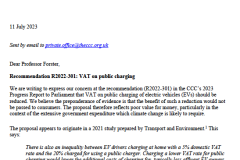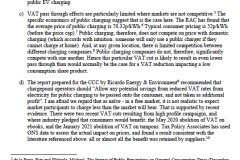There are currently high-profile campaigns to scrap VAT on sunscreen, and scrap VAT on public electric vehicle (EV) charging. The proposals would waste public money, and fail to achieve their objectives.
One of the benefits of leaving the EU is that the UK is no longer bound by EU VAT law, and we can create, or abolish, whichever VAT exemptions and special rates we wish. One of the downsides is that a large number of lobbyists and campaign groups are currently pushing for VAT cuts.
Here’s the Melanoma Focus campaign:

And here’s a 2021 study prepared by Transport and Environment for the Climate Change Committee:

Transport and Environment is a serious organisation, and Melanoma Focus is a serious charity. They are right to identify a public benefit in increased takeup of EVs and increased usage of sunscreen. But their proposals make three serious mistakes.
- They assume that cutting VAT will result in a price cut for consumers. Unfortunately, the evidence is that most of the cut will be retailed by retailers/suppliers, and only some (and perhaps none) “passed-through” to consumers.
- They don’t consider the deadweight cost – only a small part of the benefit of the VAT cut is going to the “new” consumers, enticed to buy the product by the VAT cut. The rest is being given to people who would have bought the product anyway.
- They don’t consider the opportunity cost – was there another way to achieve the aims (increased product take-up) more effectively/efficiently than the VAT cut? What about directly subsidising the product?
It’s worth looking at these issues in detail:
Most of the benefit won’t go to consumers
There’s a common intuition that a reduction in a producer’s cost (like VAT) will result in the producer lowering its prices. After all – the argument goes – the price of a product is made up of the cost of production plus a profit markup. So if the cost drops, the price will drop. And VAT is a cost, so if we reduce VAT, the price will drop.1Professors Rita de la Feria and Michael Walpole wrote written about this intuition and its consequences in a compelling paper – highly recommended.
But that’s wrong. In a market economy, economic actors charge what the market will bear. Hence, in principle, there is no reason to assume that prices will reflect the level of VAT; each case must be looked at on its own facts.
IMF researchers analysed 14 years’ VAT changes across seventeen countries, and were able to identify clear patterns in when changes in VAT rates (up and down) were “passed-through” to consumers, and when they were not. They found that the degree of “pass through” was strongly related to the percentage of overall consumption (the “consumption share”) that is affected by the change. There is no significant pass through when the consumption share is less than 10%. And when a VAT cut is targeted on one specific product or service (EV charging or sunscreen), the consumption share will always be much less than 10%.2Counter-intuitively there is also no passthrough when the consumption share exceeds 60%. That might explain the IFS’s surprising finding that the temporary 2.5% VAT cut in 2008 was only passed-through for the first few months
The National Bureau for Economic Research looked at an even larger dataset a couple of years later, and concluded that pass through is even lower for VAT cuts than it is for VAT increases.
So we should start out very sceptical of claims that VAT cuts will be passed to consumers.3We can expect even worse pass-through for public EV charging than sunscreen, given that the public EV market is much less competitive
Promises from suppliers to pass on the benefit of VAT cuts are worthless
In a free market, it’s not realistic to expect suppliers to charge less than the market will bear. Promises may be made in good faith, but months later, commercial imperatives will be hard to resist.
There were two recent VAT cuts resulting from high-profile campaigns where industry pledged that consumers would benefit: the May 2020 abolition of VAT on ebooks, and the January 2021 abolition of VAT on tampons.
Here’s how the Publishers Association lobbied to abolish VAT on ebooks:

And here’s what actually happened. Comparing ebooks with other electronically-supplied products, as well as with paper books, there’s no evidence of any price cut being passed to consumers.4Our detailed analysis with all code and underlying data is here

Many retailers promised to pass on the abolition of VAT on tampons. Here’s what actually happened: perhaps 1% of the 5% cut was passed to consumers.5Again, all the analysis, code and underlying data is available

It’s common for suppliers to lobby for VAT cuts, and I expect many of the VAT cuts included in the IMF and NBER research were accompanied by promises that consumer prices would fall. We therefore shouldn’t be surprised that these two UK examples are consistent with the general evidence on pass through.
Deadweight cost
The UK sunscreen market is worth £169m, implying that a VAT cut would cost about £30m.
Imagine if we could use that £30m to put high SPF sunscreen directly in the hands of the people that should use it, but don’t, and then persuade them to use it. That would be perfectly efficient, with zero “deadweight cost”.
A VAT cut doesn’t do that at all. First, a big chunk of the £30m will be kept by retailers, and not passed to consumers (on the basis of the evidence above, that’s probably most of the £30m). Then, of the remaining part, most will go to cut sunscreen prices for people who were going to buy sunscreen anyway. Only the last remaining fraction is doing what we actually want to do – going to “new” sunscreen users who we successfully enticed to buy sunscreen.6It’s disappointing to see campaigners running surveys asking people leading questions about whether they’d use more sunscreen if the price was reduced by 20%. That tells us little about what people would actually do. The rest – the majority, and perhaps almost all – is “deadweight cost”.
The same goes for public EV charging. Suppliers will pocket most of the benefit of any VAT cut. Then most of what’s left will go to people who already own EVs. Only a small remaining fraction will go to people who were enticed to buy an EV by the VAT cut. The rest, again, is deadweight cost.
The bottom line: we can expect the deadweight cost to be very high, and plausibly close to 100%.
This is a problem inherent in VAT. It’s why whilst VAT cuts often appear a simple and obvious way to achieve social aims, VAT is usually a poor tool for this purpose.7The deadweight cost problem with VAT also kiboshes the much better argument for a VAT cut on EV charging: that it increases the profitability of suppliers, and so incentivises more construction of EV chargers. The deadweight cost here is large, because you are cutting the VAT, and enhancing the profitability, for existing chargers, not just new ones. Much better to directly subsidise new EV chargers.8There is also a distributional problem: most VAT cuts will benefit those who consume more, i.e. those on higher incomes
Opportunity cost
The opportunity cost is: what else could we have done with the money? Are there options that would reach more people, more efficiently than a VAT cut? (Or, another way to put it, with a lower deadweight cost?)
Some obvious alternatives:
- Simply giving sunscreen away to people who we identify as being particularly at risk of under-using sunscreen. We could buy a lot of sunscreen for £30m – probably six million bottles. Then give it away at food banks, schools, beaches, airports…
- An education campaign. Is cost really the main reason behind low sunscreen usage? Published figures suggest usage levels are too low to be explained by affordability.
- More targeted campaigns. Some Australian state governments hire people to patrol beaches, spotting people who are not using sunscreen, giving them free sunscreen, and even trying to persuade them to use it.
- Should we also be learning from the Australian experience educating children to cover up? Should we be subsidising/giving away sunhats as well as sunscreen?
I am not a health policy expert. I don’t know which of these would be most effective, or what other solutions might exist. But it’s hard to imagine how any alternative would be worse than a VAT cut, where almost all the benefit goes to retailers, and most of the rest to people who don’t need it.
Writing to the CCC
The Climate Change Committee took forward Transport and Environment’s recommendation, and have recommended a VAT cut to Parliament.
Professor Rita de la Feria and Professor Judith Freedman are two of the world’s leading tax policy academics. The three of us have written an open letter to the CCC, asking it to reconsider – thumbnails below, and PDF copy available here.
Photo by BATCH by Wisconsin Hemp Scientific on Unsplash, edited by our team
-
1Professors Rita de la Feria and Michael Walpole wrote written about this intuition and its consequences in a compelling paper – highly recommended.
-
2Counter-intuitively there is also no passthrough when the consumption share exceeds 60%. That might explain the IFS’s surprising finding that the temporary 2.5% VAT cut in 2008 was only passed-through for the first few months
-
3We can expect even worse pass-through for public EV charging than sunscreen, given that the public EV market is much less competitive
-
4Our detailed analysis with all code and underlying data is here
- 5
-
6It’s disappointing to see campaigners running surveys asking people leading questions about whether they’d use more sunscreen if the price was reduced by 20%. That tells us little about what people would actually do.
-
7The deadweight cost problem with VAT also kiboshes the much better argument for a VAT cut on EV charging: that it increases the profitability of suppliers, and so incentivises more construction of EV chargers. The deadweight cost here is large, because you are cutting the VAT, and enhancing the profitability, for existing chargers, not just new ones. Much better to directly subsidise new EV chargers.
-
8There is also a distributional problem: most VAT cuts will benefit those who consume more, i.e. those on higher incomes





4 responses to “Why scrapping VAT on sunscreen and public EV charging would be an expensive waste of money”
All very convincing to me. A broad base simplified VAT seems like good policy.
However, on the flip side I would be interested to hear more on whether VAT rises (or applying other transaction taxes) on particular goods and services is good or bad policy? Thinking particularly about products where there are negative externalities such as environmental and healthcare costs.
In the case of e-books as there has been no benefit passed onto the consumer by removing VAT why not reverse the policy/law with immediate effect? Amazon/Publishers Association would initially complain and raise prices but then they would have to justify why the full benefit when VAT was removed was NOT passed onto consumers which would be a PR disaster for them.
It would also be a win for the Govt to show that if a change in law/policy does not work then they are able to acknowledge and act on real information. Could even lead to other changes being reversed when the benefit promised never materialised?
This reminds me of when I was paying £16.50pm for Financial Times in 2020 and they sent me an email that VAT would no longer be charged to digital news websites. I got excited until they told me that my subscription price would stay the same. I cancelled and they now charge £35pm for the exact same subscription only three years later.
Well said, all complete common sense. But in the face of the undoubted facts countries all over the globe are cutting taxes on ‘essentials’ to counter inflation. Why would they do that when all the evidence is to the contrary?
The reason is that that ‘saying’ that prices will be reduced, you are helping people, you are standing together with the common folk, are all things that are like nectar to most politicians. And they are ultimately the people who decide tax policy.
The reason is that they give an immediate pay off in popularity, everyone likes you and as a Politician, there is no greater feeling. The full ramifications won’t be apparent until years later. Same with printing more money, QR. There could be a new Parliament by then, when the penny drops. even a new Government, and a myriad of other things that happen in that period that you can later use to mask the stupidity of reducing taxes. This could be general global inflation, wars, weather, the possibilities are endless. Sir Humprey Appleby would not even break a sweat in re-imagining the original policy decision.
So, laudable as what you are doing is, and I agree 100% with everything you, Judith and Rita say, the Political interfering is likely to, well, interfere. Elephant in the room, there is an election probably next year. Having said that, on a number of occasions recently that I have seen, the Treasury Ministers in dealing with these lobbyist based claims have been pretty clear in the fact the Country all of it, needs the dough, not just the immediate beneficiaries of the lobbying, be that the EV Driver or the EV company.
This general position should in my view be the main’ rule’ – the country, all of it, needs the tax, so if we all chip in…